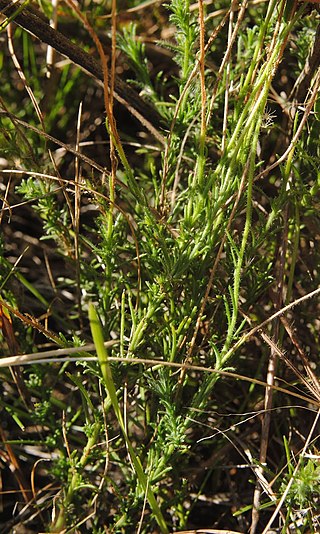
Nothoscordum is a genus of New World plants in the onion tribe within the Amaryllis family. It is probably paraphyletic. The genus is native to North, Central and South America, though a few species have become naturalized in various parts of the Old World.
Parodiodendron is a monotypic plant genus under the family Picrodendraceae, described as a genus in 1969. The sole species is Parodiodendron marginivillosum(Speg.) Hunz..

Pamianthe is a genus of South American bulbous perennials in the Amaryllis family, subfamily Amaryllidoideae. They can be found in sandy, but rocky areas in Colombia, Ecuador, Peru, and Bolivia.

Hysterionica is a genus of flowering plants in the family Asteraceae.

Mastigostyla is a genus of flowering plants in the family Iridaceae, first described as a genus in 1928. The entire group is endemic to South America. The genus name is derived from the Greek words mastigos, meaning "whip", and stylos, meaning "style".

Stenomesson is a genus of bulbous plants in the family Amaryllidaceae. All the species are native to western South America.

Clinanthus is a genus of bulbous plants in the family Amaryllidaceae. It is found in western South America, including Ecuador, Peru, Bolivia, north Chile and north west Argentina.

Miersia is a plant genus in the Amaryllidaceae. The genus has 10 known species, 9 of which are endemic to Chile and one, M. rusbyi, endemic to Bolivia.

Eustephia is a genus of South American plants in the Amaryllis family. All 6 known species are native to Peru, with the range of one species extending also into Bolivia.

Paramongaia is a genus of South American plants in the Narcissus Family ( Amaryllidaceae), the most important species being Paramongaia weberbaueri found only in the Andes of Peru and Bolivia. Common names are "giant Peruvian daffodil." and Cojomaria. Its appearance resembles the "King Alfred" Daffodil, but the flower is up to 7.25 inches in length by 7.5 inches wide with a corona 3.3 inches by 3 inches long by three inches wide.

Philibertia is a genus of flowering plants in the family Apocynaceae, first described as a genus in 1819. It is native to South America.

Balbisia is a genus of flowering plants belonging to the family Francoaceae. It is also in the Vivianiaceae subfamily.

Hippeastrum striatum, the striped Barbados lily, a flowering perennial herbaceous bulbous plant, in the family Amaryllidaceae, native to the southern and eastern regions of Brazil.

Eustephieae is a flowering plant tribe in the family Amaryllidaceae, subfamily Amaryllidoideae. It forms part of the Andean clade, one of two clades in The Americas.
Darcyanthus is a monotypic genus of flowering plants belonging to the family Solanaceae. The single known species is Darcyanthus spruceanus(Hunz.) Hunz. ex N.A.Harriman
Saracha is a genus of flowering plants belonging to tribe Physaleae of subfamily Solanoideae of the nightshade family Solanaceae. The genera most closely related to Saracha are Iochroma, Dunalia, and Vassobia.
Hawkesiophyton is a genus of flowering plants belonging to the family Solanaceae. It is also in Solanoideae subfamily, Tribe Solandreae Miers and also Subtribe Juanulloinae.

Niedenzuella is a genus of flowering plants belonging to the family Malpighiaceae.

Pamianthe peruviana, also known as the giant Peruvian daffodil, is a species of epiphytic plant native to seasonally dry areas of Peru and Bolivia.














